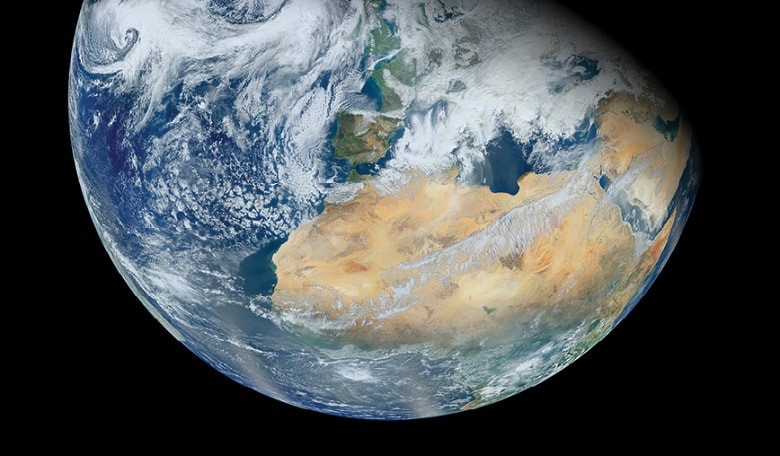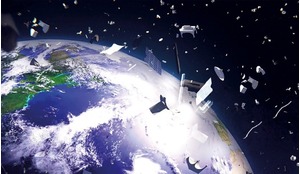Our sister world Venus is almost the same size as Earth and probably had oceans at the beginning. But Venus orbits closer to the Sun and was never in the Goldilocks, or habitable zone. Instead it quickly spiralled into a greenhouse effect that erased its oceans and left a desert planet, coated with dense clouds of sulphuric acid and an atmosphere composed almost entirely of carbon dioxide. That kind of death spiral will happen to Earth - either if we fill the atmosphere with greenhouse gases or if we just wait one or two hundred million years as the inner edge of our Sun’s habitable zone moves past our planet’s orbit.
Anyone who saw Woody Allen’s movie Radio Days knows that we were promised five billion more years of having a habitable planet! Sure, it’s five billion until our G-type star leaves the main sequence, expands prodigiously and eats Earth. But a long time before that the Sun’s gradual increase in temperature is going to make our planet uninhabitable, perhaps as soon as one hundred million years from now - about the same timescale it took for mammals to evolve into us after an asteroid killed the dinosaurs.
Our world skates the very inner edge of the Golidlocks zone. This is why only a little bit of carbon dioxide generated by human industry is causing problems. In order to lose heat fast enough we need an atmosphere that’s almost completely transparent. Scientists believe every watery world exists in what’s called a Gaia balance in which natural feedback loops adjust the amount of greenhouse gas so that the seas stay liquid. This close to the habitable zone’s inner edge that balance is maintained by very, very low greenhouse levels. The inner edge is creeping outward - much slower than human-generated climate change but still too fast for comfort.
Already there is discussion about what to do. Some say let’s become a spacefaring people, occupying other worlds and filling the Solar System with vibrant life. Europa, Mars, the asteroid colonies - but also, interstellar. As Elon Musk recommends, let’s put our eggs in many baskets.
Still, like me, you’d probably hanker to do something to help the planet that’s been so kind (and patient) with us. I have some emotional attachment to this place. I’d like it to survive longer. Can’t we do something for our home?
Whatever method you come up with is going to have to survive disruptions and pauses, even changes of species
So, let’s lift the Earth - raise up the whole planet and move out of harm’s way!
One method, if we were to get out into the Solar System - would be to steer asteroids. The Planetary Resources company and others are already eyeing the wealth of resources out there. Suppose our descendants were to use this capability to target thousands of asteroids to swing past the Earth in near misses, transferring a fraction of their forward momentum to the planet with each pass and gradually pumping-up its orbit, thus increasing its distance from the Sun and staving off the heat by just enough.
Sure, it might work, if you were to fly such near misses million of times, throwing away valuable asteroids that might have a myriad other uses. In those ten million near brushes, what god-like level of competence would be required in order to know for sure that none of those rocks would veer a little bit and strike the planet?
Another possibility is the ‘gravitational tug’. There is already a clear concept how we might use this method to move asteroids that are heading toward Earth and shift them out of the way. Take a heavy spacecraft, hover it near the asteroid and thrust away with ion engines, just enough so that it does not escape the asteroid’s gravity. In that case the asteroid follows the spacecraft, hence the idea: humanity could set up an asteroid at the L1 or L2 or L5 Lagrangian points of Earth’s orbit and tug Earth away.
Sound implausible? Maybe it’s time to take a closer look at what it takes to move a planet. Let’s look at those power requirements, very roughly. Assume that you want to enlarge or widen Earth’s orbit by about one tenth of an astronomical unit (0.1 AU) outward per hundred million (1 x 108) years.
The planet’s mass is 6 x 1024 kg (six trillion trillion kg). Its orbit velocity around the Sun is 29.5 km/s. Keeping the orbit circular requires lifting both perihelion and aphelion 0.1AU outward. That will require adding more velocity, a ‘deltaV’ of about 1.4 km/s. The work done is 2.4 x1032 J, or about a billion trillion trillion Joules.
The number is truely ‘astronomical’ and clearly it isn’t going to happen by flinging asteroids past Earth, or tugging with an ion drive on a nearby asteroid. You can trade force for time. But you are going to need a lot of both.
Let’s start with time. It’s going to take millions of years to lift something as heavy as the Earth with little nudges. Generations. Eons. The lifespan of whole civilisations. Whatever method you come up with is going to have to survive disruptions, pauses or even changes of species.
Miracle cables
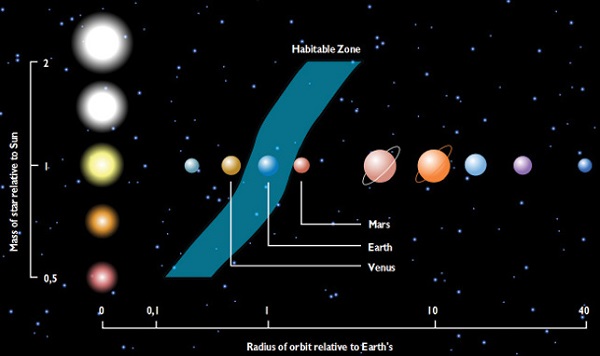 The Goldilocks zone, the area of space in which a planet is just the right distance from its home star so that its surface is neither too hot nor too cold
The Goldilocks zone, the area of space in which a planet is just the right distance from its home star so that its surface is neither too hot nor too cold
Alternatively, let’s look at electrodynamic tethers. I talk about them in my novel Existence. As the world expert on tethers, Joe Carroll has indicated, if you allow a conducting cable to settle into gravity as it is orbiting around Earth, it will be stable along a radius from the centre of Earth. This is called gravity gradient stabilisation.
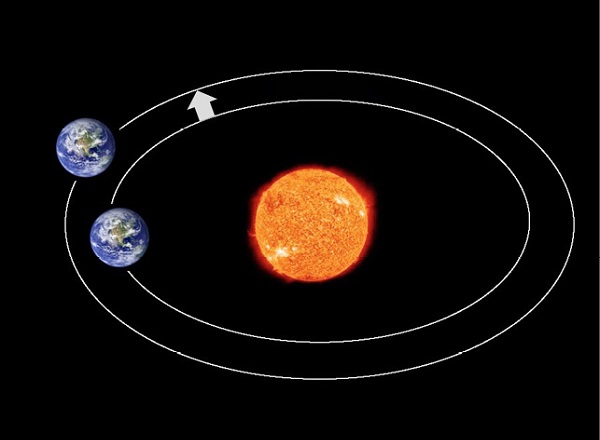 Could shifting Earth to a different orbit ultimately be feasible?
Could shifting Earth to a different orbit ultimately be feasible?
Let’s say the tether is made of a conductive material. This orbit is cutting through Earth’s magnetic field so an electromotive force (EMF), or voltage, becomes induced - just like the armature of a generator - along the length of the tether. If you were to spew electrons off one end of the cathode, you would then be able to suck energy out of the orbit. The tether would slowly go down but you’d get all the power you need for an orbiting space station.
But now let’s say you have lots of power (with a fusion plant or lots of solar cells) and decide to push electrons against the EMF, so that they spew out the other end (and assume the circuit can reconnect via an ionosphere). Now you no longer have the armature of a dynamo but that of a motor. You’re cranking against Earth’s magnetic field and the electrodynamic tether rises.
Space elevators
Clearly this is a relative of the now-famous space elevator, a tether anchored to Earth at the equator with a counterweight beyond geosynchronous orbit. New carbon nanotubes may make space elevators a reality.
Let’s combine these concepts and imagine a space elevator that is electrically conducting - cutting through Earth’s magnetic field which will tug on Earth - and maybe pull it upward. Alas, there’s a problem. Earth, with a 24-hour day, is rotating so fast it would be very difficult to time the pumps in just the right way so that the effect is not on Earth’s rotation but on its orbit.
Remember, you have to add momentum to Earth’s orbit - so that it gets farther from the Sun - but an Earth beanstalk would be leveraging against Earth’s own magnetic field. Like trying to lift yourself by your own bootstraps.
But, what if you put a space elevator on the other side of the Moon? Its day-to-day function would be to take commerce in, receiving resources from the asteroids, perhaps sending out refined, developed materials as part of a lunar industry. People would be counting on this space elevator without thinking about what it going on in the background. Moreover, if it falls, not a lot of damage. If it breaks, the cable just floats away into space.
Now, let’s think through some of the technical details. If the cable were also electrically conducting, you now have an electrodynamic tether hanging outward from the Moon at 60 Earth radii from our planet. That means it is now cutting through the Sun’s magnetic field not Earth’s (except when it passes through the ‘geo-tail’ for part of one day each month). You can push and pull against that and move Earth relative to the Sun. Moreover, it takes a month for the Moon to orbit Earth, so it is much easier to time the pumping of the electrons. A rhythmic pumping that is continuously tugging on the Moon - and, as it tugs the Moon tries to rise, but Earth resists - and follows!
Practical requirements
That’s the theory but what do the numbers say? First, we immediately run into a scale problem Earth’s magnetic field is very strong - 25,000 nanotesla in low Earth orbit (LEO), near the equator - and we’ve already seen we cannot use that to move Earth, only satellites near it. In contrast, the Sun’s magnetic field at Earth’s radius from Sun (1 AU) is only ~1 nanotesla.
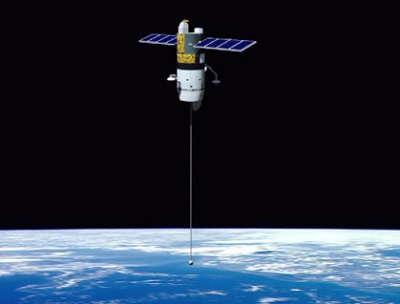 Artist’s concept of an orbiting vehicle using an electrodynamic tethers propulsion system. Relatively short electrodynamic tethers can be used to push against a planetary magnetic field to achieve propulsion without the expenditure of propellant
Artist’s concept of an orbiting vehicle using an electrodynamic tethers propulsion system. Relatively short electrodynamic tethers can be used to push against a planetary magnetic field to achieve propulsion without the expenditure of propellant
This is partly compensated for by the fact that Earth’s velocity around the Sun is four times higher than a satellite in LEO. Put it all together and you induce along the beanstalk’s length an EMF of ~200V/km. If our baseline tether, suspended outward from the far side of the Moon is, say 50,000 km long (a hefty engineering feat in itself) and if we also assume use of superconductors, then it should be possible to induce many kV - and the associated force.
The EM tether trick would require having a cloud of electrons nearby that can complete the circuit. In effect, to make this work, our descendants may need to generate sufficient electron densities near the Moon to provide it with an ionosphere. A challenge, as would be ohmic losses and the inefficiency of pumping during the whole orbit.
Let’s assume a probably optimistic average efficiency of ~25 per cent. This gives an intentionally round number of order 1X1033 joules, to be supplied in a hundred million years. That requires 3.2X1017 watts average power during that time. Now let’s triple that, because there will likely be many times when the tether-elevator isn’t properly used, is ignored or does not exist. Call the requirement 1018 watts (a billion gigawatts).
The current energy use of Earth civilisation is about 20 terawatts (20,000 gigawatts). So, it would seem that our Earth lifting system would need to apply only 50,000 times the total generating capacity of all artificial energy systems currently used by humankind.
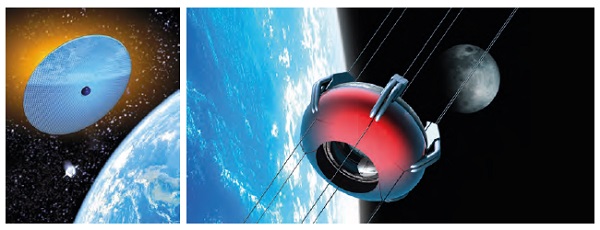 Bottom left: Parasol shades might buy a civilisation time to get on with the other more ambitious and longlasting solutions.
The concept of an elevator to space is not new. It has long been supposed that by creating a very, very long tether from Earth to above geostationary orbit, secured to a counterweight, it could be possible to both drop and lift cargo to Earth for relatively little energy cost.
Bottom left: Parasol shades might buy a civilisation time to get on with the other more ambitious and longlasting solutions.
The concept of an elevator to space is not new. It has long been supposed that by creating a very, very long tether from Earth to above geostationary orbit, secured to a counterweight, it could be possible to both drop and lift cargo to Earth for relatively little energy cost.
Putting it in perspective - if we have 40 per cent efficient multi-junction solar cells tracking the Sun, with a solar intensity that remains roughly constant as we spiral out, we would need 5.8 x1014 m2 of solar cells. That is 1.1 times the total surface area of Earth.
Parasol shades
Let’s take a look at a project that is of similar scale, easier (by far) for a primitive civilisation like ours to implement but with other disadvantages. For our purposes, it will set things in perspective.
Let’s imagine a space elevator that is electrically conducting - cutting through Earth’s magnetic field which will tug on Earth - and maybe pull it upward
A shade parasol, established a bit sunward of the L1 Lagrangian point, ~1.5 X 109 m sun-ward of Earth, with the purpose of countering global warming by slightly reducing the amount of sunlight hitting the planet. Such a parasol might cool the planet by the same amount as increasing the planet’s orbit by 10 per cent, just by removing 17 per cent or so of the sunlight. This requires a parasol a bit more than half Earth’s diameter (about 7000 km).
This approach for cooling the Earth has the advantages of somewhat smaller surface area, and not requiring a lunar beanstalk to work with. Those are countered by the fact that any shading system must be constantly maintained. Heating resumes the moment the parasol drifts away from the Earth-Sun line and, as before, the effects might be especially devastating if quick repairs were not possible.
In contrast, Earth-lifting via a lunar beanstalk can survive any such setbacks and the cooling effects of each increment of orbital change
are permanent.
Of course, some combination of these methods might serve the purposes of our descendants and the skills required for one would help the other. Parasol shades might buy a civilisation time to get on with the other more ambitious and long-lasting solutions.
Geoengineering
The question is, could this solve our problems now, with global climate change? There’s a branch of science called geoengineering but many people are opposed to even thinking about it. However, there’s nothing wrong with doing preliminary experiments. Of course our number one job is to prevent things that we are doing that are harming the Earth.
 Magellan synthetic aperture radar mosaic of Venus
Magellan synthetic aperture radar mosaic of Venus
Indeed, most of the actions required to prevent global climate change are things we ought to do anyway. Actions that would help us to become more energy-efficient and save money, while alleviating the rise in Earth’s greenhouse gases. We should be able to talk about options to find win-win engineering projects that could help us save the planet.
Without endangering Earth with dangerous asteroid flybys you pump it outward with an electrically conductive space elevator on the far side of the Moon
But this article is about the much longer term, assuming that we grow up enough to solve our current problems and care about the big… really big… picture.
This is how you raise the planet, without endangering Earth with dangerous asteroid flybys. You pump it outward with an electrically conductive space elevator on the far side of the Moon.
The great advantage is that civilisations can rise and fall. Budgets can be cut. The tether can be cut; it just floats away. You replace it. Over the course of millions of years, all you need is for phases of rich civilisations to do this - maybe half the time - as the Sun’s heat continuously moves our habitable or Goldilocks zone further outward.
Is this concept too ambitious? For now, perhaps. But it’s not too soon to be thinking - even if just in science fictional terms for no other reason than it’s good to develop the habit of both thinking long-term and pondering our duty to preserve the planet. Sure, there are many more immediate dangers to Earth and we need to be considering creative solutions to those as well. But it is also possible to start pondering the ambitions that our rich and fantastically capable descendants might undertake to save this little globe that’s been very good to us.
David Brin is an astrophysicist whose novels include ‘The Postman’, ‘Earth’‘and ‘Existence’. His non-fiction book about the information age is ‘The Transparent Society’. An extended explanation of the ‘lift the Earth’ concept can be found on his website: www.davidbrin.com





